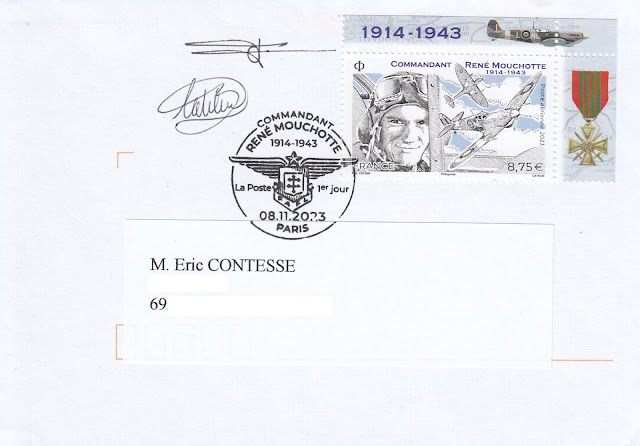Timbre "Poste aérienne - René Mouchotte (1914-1943)" sur FDC de France
Le 13 novembre 2023 (vente générale), la poste française a mis en circulation un nouveau timbre dans sa série "Poste aérienne", consacrée cette fois à René Mouchotte (1914-1943), aviateur et figure de la France libre pendant la 2ème Guerre mondiale, à l'occasion du 80ème anniversaire de sa disparition.
Ce timbre (8,75€ - tarif pour un envoi international entre 100g et 250g, tirage : 408000), conçu par Pierre-André Cousin et gravé par Elsa Catelin, a été utilisé sur cette lettre avec TAD Premier Jour (emblème des Forces aériennes françaises libres - FAFL) de Paris du 8 novembre 2023. Merci beaucoup André !
A noter les signatures des 2 artistes sur l'enveloppe.
Un portrait de René Mouchotte aux commandes d'un chasseur Hawker Hurricane de la Royal Air Force est représenté sur ce timbre, ainsi qu'un Supermarine Spitfire britannique en vol à droite, son avion emblématique.
Ce timbre a été imprimé dans un feuillet composé de 12 timbres avec marges illustrées incluant en particulier certaines de ses décorations, comme la "Croix de guerre 1939-1945" ci-dessous.
On November 13, 2023 (general sale), the French Post put into circulation a new stamp in its "Airmail" series, this time dedicated to René Mouchotte (1914-1943), aviator and figure of Free France during the Second World War, on the occasion of the 80th anniversary of his death.
This stamp (€8.75 - rate for an international shipment between 100g and 250g, print run: 408,000), designed by Pierre-André Cousin and engraved by Elsa Catelin, was used on this cover with First Day postmark (emblem of the Forces aériennes françaises libres - FAFL) from Paris on November 8, 2023. Thank you very much André!
To note the signatures of the two artists on the envelope.
A portrait of René Mouchotte flying a Royal Air Force Hawker Hurricane fighter is depicted on this stamp, as well as a British Supermarine Spitfire in flight on the right, his iconic aircraft.
This stamp was printed in a sheetlet made up of 12 stamps with illustrated margins including in particular some of his decorations, such as the "War Cross 1939-1945" below.
Moins d'un mois après l'Appel du 18 juin du général de Gaulle, René Mouchotte signe son engagement dans la Royal Air Force le 13 juillet 1940.
En octobre 1940, promu adjudant, il est affecté au Squadron 615, le "Churchill Squadron", et prend part avec son unité à la fin de la bataille d'Angleterre, effectuant entre 2 et 4 sorties quotidiennes face aux Messerschmitt allemands.
En juillet 1941, il est nommé lieutenant et chef d'escadrille, étant ainsi le premier étranger à commander un squadron britannique. Le 26 août 1941, il abat son premier appareil ennemi, un Junker 88, et, en quelques semaines, incendie plusieurs bateaux allemands dans la Manche.
Le 14 juillet 1942, le général de Gaulle lui remet la Croix de Guerre avec palme. En août 1942, il prend part à l'opération "Jubilee" au-dessus de Dieppe. Celui que les britanniques surnomment "Capitaine René" est ensuite promu au grade de commandant et reçoit la charge d'un squadron britannique, le 65 Squadron.
Le 9 janvier 1943, il reçoit le commandement du Groupe de Chasse "Alsace" stationné à Biggin Hill dans le sud de l'Angleterre. Il compte rapidement 1743 heures de vol et 408 missions de guerre.
Le 27 août 1943, au cours d'une mission de protection de forteresses volantes B 17, il est abattu en vol au-dessus de la Manche. Son corps ne sera identifié qu'en mars 1949.
Less than a month after General de Gaulle's Appeal of June 18, René Mouchotte signed his enlistment in the Royal Air Force on July 13, 1940.
In October 1940, promoted to warrant officer, he was assigned to Squadron 615, the "Churchill Squadron", and took part with his unit at the end of the Battle of Britain, carrying out between 2 and 4 daily sorties against the German Messerschmitts.
In July 1941, he was appointed lieutenant and squadron leader, thus being the first foreigner to command a British squadron. On August 26, 1941, he shot down his first enemy aircraft, a Junker 88, and, within a few weeks, burned several German boats in the Channel.
On July 14, 1942, General de Gaulle awarded him the War Cross with palm. In August 1942, he took part in the Operation "Jubilee" above Dieppe. The one the British nicknamed "Captain René" was then promoted to the rank of commander and given charge of a British squadron, the "65 Squadron".
On January 9, 1943, he received command of the "Alsace" Fighter Group stationed at Biggin Hill in the south of England. He quickly accumulated 1743 flight hours and 408 war missions.
On August 27, 1943, during a mission to protect B 17 flying fortresses, he was shot down in flight over the English Channel. His body would not be identified until March 1949.

Aucun commentaire:
Enregistrer un commentaire